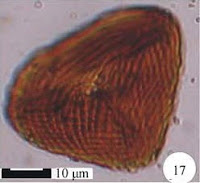Angiosperms (Flowering Plants) are the dominant plants in almost all modern ecosystems, producing a wide variety of woody and herbaceous forms. The earliest Angiosperms are thought to have been woody in nature, as the group they arose from, the Gymnosperms (Conifers, Cycads, Ginkos etc.) are exclusively woody today, and appear to have been so throughout their history (some putative herbaceous Conifers have been described from the Triassic of France, but these are disputed). The first Angiosperm pollen appears in the fossil record in the Triassic, with Angiosperm macrofossils appearing in the Jurassic and the group rising to dominance in the Early Cretaceous. However herbaceous plants lacking woody material have limited preservational material, so while herbaceous Angiosperms could potentially have been present since the Triassic, the origin of such plants is unclear.
In a paper published in the journal Acta Geologica Sinica on 18 February 2016, Han Gang of the Palaeontological Center at Bohai University, Liu Zhongjian of the Palaeontological Center at Bohai University and the Shenzhen Key Laboratory for Orchid Conservation and Utilization at the National Orchid Conservation Center of China and Orchid Conservation & Research Center of Shenzhen, Liu Xueling, also of the Palaeontological Center at Bohai University, Mao Limi of the State Key Laboratory of Palaeobiology and Stratigraphy at the Nanjing Institute of Geology and Palaeontology, Frédéric Jacques of the Key Laboratory of Tropical Forest Ecology at the Xishuangbanna Tropical Botanical Garden, and Wang Xin, also of the State Key Laboratory of Palaeobiology and Stratigraphy at the Nanjing Institute of Geology and Palaeontology, describe a herbaceous Angiosperm from the Middle Jurassic Jiulongshan Formation of Inner Mongolia.
The Daohugou Beds of the Jiulongshan Formation are a fossil Lagarstätte
from Ningcheng County in Inner Mongolia, which have produced a large
number of well preserved Middle Jurassic Vertebrates, Insects, Plants
and other fossils. The
deposits comprise coarse conglomerates, sandstone, mudstone and thin coal layers laid down in a lake surrounded by a moist, warm-temperate forest,
dominated by Conifers, Ginkos and Cycads.
The new Angiosperm is named Juraherba bodae, where 'Juraherba' implies 'Jurassic Herb' and 'bodae' is a Chinese diminutive of Bohol University. The species is described from a single specimen, a complete plant 38 mm in length, with a preserved root system, elongate, blade shaped leaves similar to those of modern Grasses and four fructifications, one of which is split open sufficiently to reveal an internal seed, clearly identifying the plant as an Angiosperm.
General morphology and details of Juraherba. (a) Whole plant with physically connected parts including roots (r), stem (s), leaves (f), and fructifications (1-4). Note an associated fossil insect (arrow) at the top. Scale bar is 10 mm. (b) Helically arranged leaves (1-6). Scale bar is 0.5 mm. (c) Coalified lower portion with scales (white arrows) and hairy roots (black arrows). Scale bar is 0.5 mm. (d) Fructification 3 in Fig. 2a, with longitudinal ridges (arrows) and some coalified remains. Scale bar is 1 mm. (e) Margin (arrows) of a leaf (l) with smooth surface, and the stem (s) with rough surface. Scale bar is 0.5 mm. (f) One of the leaves with an array of insect damages (arrows). Scale bar is 1 mm. (g) Detailed view of one (arrow) of insect damages. Scale bar is 0.1 mm. Han et al. (2016).
The root structure of Juraherba bodae is extremely limited, leading Han et al. to suggest that it lived in a still aquatic environment. All of the frutifications appear to have been held at the same level, which Han et al. suggest may have been the water surface. The frutifications are fleshy in nature, raising the possibility that like many modern Angiosperms, Juraherba bodae may have relied on an unknown animal to dispurse its seeds by consuming these fruit.
Reconstruction of whole plant, fructification, and leaf of Juraherba. Not to scale. Han et al. (2016).
See also...
 Glenrosa carentonensis: A new species of Conifer from the Early Cretaceous of Charente-Maritime, France. Conifers of the genus Glenrosa were first recorded from the
Early Cretaceous Glen Rosa Formation of Texas in 1984 (although specimens of
the plant had been collected in the area since the 1890s)...
Glenrosa carentonensis: A new species of Conifer from the Early Cretaceous of Charente-Maritime, France. Conifers of the genus Glenrosa were first recorded from the
Early Cretaceous Glen Rosa Formation of Texas in 1984 (although specimens of
the plant had been collected in the area since the 1890s)... Pollen and Spores from the Early Cretaceous Damoguaihe formation in eastern Mongolia. The Damouguaihe formation is found in the Hailar Basin in Inner
Mongolia, where it has been accessed from a number of coal mines (it
never naturally outcrops at the surface). More recently it has also been
found in the Tamutsag Basin of Mongolia, where it has been accessed by
exploration wells sunk by oil...
Pollen and Spores from the Early Cretaceous Damoguaihe formation in eastern Mongolia. The Damouguaihe formation is found in the Hailar Basin in Inner
Mongolia, where it has been accessed from a number of coal mines (it
never naturally outcrops at the surface). More recently it has also been
found in the Tamutsag Basin of Mongolia, where it has been accessed by
exploration wells sunk by oil... Traces of Insect oviposition on Ginko leaves from the Middle Jurassic Daohugou Biota of Inner Mongolia. Plants and Insects are the most abundant organisms in modern terrestrial
ecosystems, and generally considered to be the most important. It is
thought...
Traces of Insect oviposition on Ginko leaves from the Middle Jurassic Daohugou Biota of Inner Mongolia. Plants and Insects are the most abundant organisms in modern terrestrial
ecosystems, and generally considered to be the most important. It is
thought...
Follow Sciency Thoughts on Facebook.


